Waves Physics & Information in Complex Systems

The challenge
Waves propagating inside disordered media leads to seemingly intractable complex interference patterns. This effect prevents conventional imaging techniques, such as optical microscopy or ultrasound imaging, to be employed in complex media. As such, this constitutes a critical challenge for biological imaging. This challenge motivates us to get a better fundamental understanding of how waves propagate in complex media.
In the last decades, the possibility to shape incident waves in space and time has been widely used to control and maximize the energy of waves within complex scattering media. In our group, we now want to control and maximize the amount of information in the measured scattered waves. For this purpose, we associate conceptual tools from wave theory and information theory, and we conduct experimental proofs of concept in optics and acoustics using state-of-the-art wavefront shaping devices.

Waves propagating through a disordered scattering medium produce highly-complex interference patterns. How much information can we extract from the scattered light?
About me
I did my PhD at Institut Langevin (ESPCI Paris, France), during which I studied light-matter interaction at the nanoscale. I then worked on waves in complex media as a post-doc, first at the Debye Institute for Nanomaterials Science (Utrecht University, the Netherlands), and then at the Interdisciplinary Laboratory of Physics in Grenoble (Université Grenoble Alpes, France). I am now working in this lab as a researcher employed by the CNRS, studying the propagation of both light waves and acoustic waves in complex media. I have always enjoyed tackling challenges in physics as an experimentalist but also through numerical and theoretical approaches.
Besides physics, I like to spend time in the mountains around Grenoble, especially for rock climbing.
